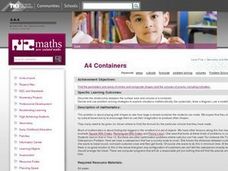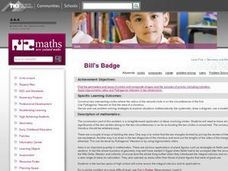Curated OER
Making Nets for Solids
Third graders are introduced to a variety of two-dimensional shapes. Individually, they are given a cube, cylinder and cone and take apart each shape. While taking them apart, they discuss how the two-dimensional shape was created.
Curated OER
Projecting Spectra
Students use two methods to show and study the colors in the visible spectrum.
Curated OER
Trace a Face
Learners find two dimensional shapes in three dimensional figures. They determine the shapes that make up the faces of three dimensional figures of common classroom objects such as crayon boxes.
Curated OER
Penny's Box
Students need to be able to calculate the volume and surface area of a cuboid as well as present a systematic list of results in order to justify the minimum case. The use of three factors of 100 is also important.
Curated OER
Plain Figures And Measuring Figures
Seventh graders investigate the mathematical concept of a sector. They apply the concept to an example problem and then move into a more complex application. They find the area of the side of a cone. This is done as students calculate...
Curated OER
The Dialogues of Difference
Young scholars research the 1067 Newark riots and examine photographs of the riots for clues as to when they were taken and what was going on. They view different historical perspectives on the riots and then write dialogues based on the...
Curated OER
What's Bright Red and Invisible?
Students study that very little sunlight penetrates the ocean below depths of 200 meters. They study that no light penetrates the ocean below depths of 1000 meters. They study that the quality of light changes as depth increase
Curated OER
Preschool Play
Future early childhood educators consider the importance of play in the preschool environment. They participate in preschool activities to identify the way play addresses different areas of child development.
Curated OER
Listen to a Shape
First graders identify basic shapes (circle, square, rectangle, triangle) and describes the attributes of each. They use magazines to find examples of each shape, and then make a collage.
Curated OER
Mondrian, Math, and Amazing Colors
Students study geometric shapes, lines, and the primary colors as they create Mondrian-like art prints.
Curated OER
Tortured Beauty
Learners compare and contrast two fundamentally different treatments of women, one Chinese and one Japanese, and to examine how this reflects on the culture that produced them.
Curated OER
Lesson- Colors of Stars
Student describes what happens to the color of a stove burner or a coal as it gets hotter. They use the applet to determine what range of temperatures range give you a red light, what range of temperatures would give you a white light,...
Curated OER
Sort It Out and Match It Up
Middle schoolers identify objects that are the same shape and size. They compare and contrast attributes of two-and three-dimensional objects using appropriate vocabulary. Pupils justify an extension of a geometric pattern to explain...
Curated OER
Light Travels As A Game
Students identify ways that light can travel and why. In groups, they develop an experiment to show that light can travel because it is a form of energy. They use this information and apply it to other forms of energy to end the...
Curated OER
Area of Parallelograms
Seventh graders review the process of finding the area of a rectangle and complete a couple of examples as a class. They discuss what a parallelogram is and what the formula would be for finding its area. They listen to an explanation...
Curated OER
ndirect Measurement Technique: Using Trigonometric Ratios
Ninth graders find the height of an object that would be difficult or impossible to measure directly. They construct and use a Clinometer to measure the angle of elevation (or depression). Students create a sketch of the measurement...
Curated OER
Fences and Posts
Fifth graders use Geoboards to demonstrate how shapes can be made by looping the rubber bands over the nails. They make a triangle on their Geoboards. At least one side of the triangle should be either horizontal or vertical. The picture...
Curated OER
Around We Go
Fourth graders investigate a range of circles, each with a different radius, diameter and circumference and assemble this information in their search for relationships.The measurement of circles and the relationships to be found within...
Curated OER
Houses
Third graders use a number of problem solving strategies in this unit of lessons. They determine how to draw and model three-dimensional objects, use co-ordinate systems, determine probability of events, and identify paths of simple...
Curated OER
A4 Containers
Fifth graders determine which container made from a single sheet of paper has the greatest volume. They look the solutions made by three different students before working on their own examples.
Curated OER
Bill's Badge
Students explore the making of circles and concepts related to them in geometry. The project is inquiry based will focus upon students making their own nametags. The construction is ideal for hands on students.
Curated OER
Karen's Tiles
Students investigate how perimeter changes as area changes to see the relation between area and perimeter for similar shapes. They then students answer the question if the area of the rectangle increase, does its perimeter have to increase?
Curated OER
Square Pegs in Round Holes
Sixth graders problem solve the square peg in the round whole problem by applying knowledge of the formulas for the areas of the circle and the square. They decide on a problem solving strategy based on logical reasoning.
Curated OER
Shapes are Everywhere
Second graders gain an understanding of geometric shapes and spatial reasoning. They learn the attributes of solid shapes in everyday activities. Students compare geometric shapes to everday objects, finding things that serve a purpose...
Other popular searches
- Volume of Prisms
- Rectangular Prisms
- Volume of Rectangular Prisms
- Prisms and Pyramids
- Surface Area of Prisms
- Rectangular Prisms Nets
- Identify Prisms and Pyramids
- Triangular Prisms
- Volume of Prisms Cylinders
- Volume Prisms
- Volume Rectangular Prisms
- Volume of Triangular Prisms

























